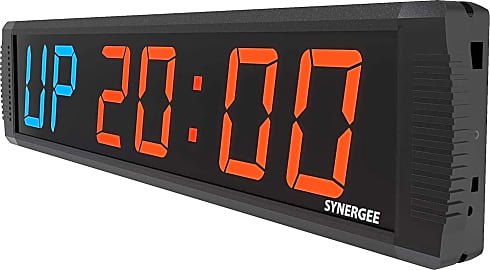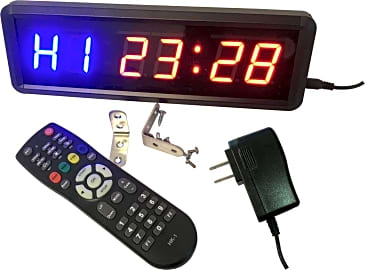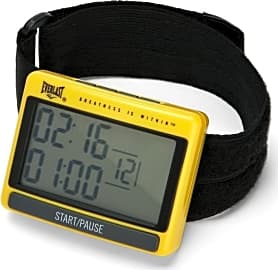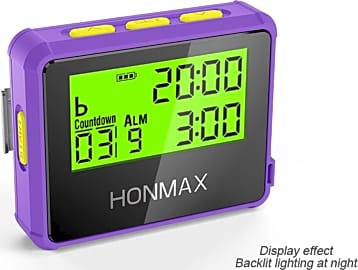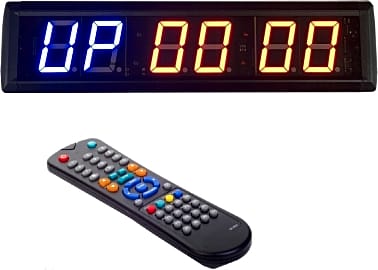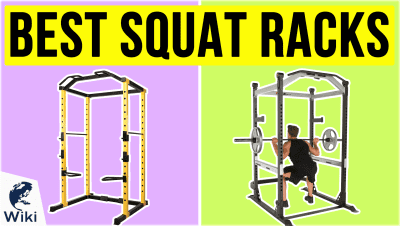The 8 Best Crossfit Clocks

This wiki has been updated 33 times since it was first published in December of 2016. When it comes to a proper CrossFit exercise routine, you actually should be watching the clock. And when you're bouncing around the gym with sweat pouring into your eyes, you'll appreciate the large, crystal-clear displays and audible alerts on these selections. We included small and large interval timers that are not only easy-to-see, but many are easy to program and customize. When users buy our independently chosen editorial picks, we may earn commissions to help fund the Wiki.
Editor's Notes
February 24, 2021:
While there are many Crossfit clocks on the market, the truth is that many of them are very similar, if not exactly the same. So, rather than inundate you with a bunch of seemingly identical models, we instead chose to include options that offer something notably different from each other, whether that be in size, display colors, or functionality.
At this time we did not remove any of our previous recommendations, however we are beginning to see some availability issues with the Honmax 8200, so if that continues we may consider removing it from the list in future updates. That being said, we did add a new option in the Everlast 7011, which we like because it comes with an arm strap so you can keep it close during intense workouts without having to worry about it falling off a belt or out of a pocket.
October 20, 2019:
When doing Crossfit, or any other type of interval-based exercise routine, it is important to have a good clock that not only keeps you abreast of the amount of time passing, but which is also versatile enough to allow for different kinds of workouts, such as every minute on the minute or Tabata routines. We made sure every clock on this list meets those needs, so you can focus on what is really important, getting into tip top shape.
In the pursuit of meeting the above mentioned specifications, we had to eliminate some models that made our list last year. Both the Marathon TI030017BK and Azoou Sport were removed because they did not have an interval feature, something we feel is integral for a good Crossfit clock.
Replacing the Marathon TI030017BK, we have the Gymboss Plus, which is also a compact, wearable model. It offers both vibration and audible alarms, so hearing impaired individuals or those who workout with headphones on will still know when it is time to rest or switch exercises. We also added the Honmax 8200, which has a bright, backlit display for nighttime use, as another wearable alternative to the removed Marathon TI030017BK.
Probably the most versatile model around has to be the GymNext Flex Home Edition. Unlike most others, that are controlled by an included remote, this one connects to an app on your phone or other smart device. It also has the ability to control synced audio playback devices and fade music in or out at the start and end of each interval. Additionally, its app can be used as a standalone fitness aid when you are exercising outside or anywhere else you don't plan on bringing the display.
Special Honors
Rogue Echo Two-Sided The Rogue Echo has four-inch digits and a display on both sides, making it ideal for placing in the center of large training facilities, especially when matched with the optional floor stand. It shows the number of rounds and time in different colors too, so there is never any confusion, and it comes with a bunch of useful preset routines, so you may not even have to waste any time trying to program it. roguefitness.com
SmartWod Timer If you already keep your phone on you during your workout and aren't looking for something to hang on a wall for a class to use, the SmartWod Timer may be all you need. It is available on both iOS and Android marketplaces and includes all the features you need, plus it boasts a workout log, which is something you don't get on traditional models. smartwod.app
The Benefits Of Crossfit Training
Now, is Crossfit the only way to achieve all of these things?
Crossfit has been all the rage in the fitness community for quite some time now, with thousands of people abandoning traditional gym memberships to train in sparse, sweaty rooms filled with ropes, plyometric boxes, and most importantly, screaming instructors. In fact, some people get so committed to these workouts, their intensity can feel almost cult-like.
So what's the big deal about Crossfit?
First off, you should know that there's not necessarily anything new or revolutionary about these workouts. They rely on concepts like interval and burst training, and the benefits of each had been well-known for decades before Crossfit came along.
That being said, no one had ever really packaged these concepts into an easy-to-follow (but certainly not easy to do) routine before.
The routines are designed to cover ten "fitness domains" — areas that athletes usually like to focus on, such as strength, endurance, and mobility. While previous exercise gurus believed you had to work on each of these categories one or two at a time, Crossfit crams them all into a single workout.
This results in practitioners who are in tremendous cardiovascular shape, while also seeing frequent and sizable gains in strength and muscle tone. Additionally, since many of the exercises are based on HIIT principles, students tend to shed fat quickly.
The core of the program is their "Workout of the Day," or WOD. Rather than commit to a set routine that you do day after day, in Crossfit you get a completely new set of exercises every session. This forces your muscles to adapt, leading to faster gains and less likelihood of plateauing. Additionally, it helps stave off boredom, increasing the odds that you'll stay committed.
And about those cult-like devotees...they may seem off-putting at first, but they also give you a built-in support network of people who want you to succeed. This isn't for everyone, of course, and these hard-core believers probably scare off as many people as they attract, but just know that they can be helpful if you give them a chance.
Now, is Crossfit the only way to achieve all of these things? Of course not. There are other routines that can offer comparable results, and you may find you just prefer some other way of training. For many people, though, it's nice to have a pre-packaged workout system where they can just show up, do what they're told, and see results fast. For others, being stuck in a room with someone constantly yelling at you feels a little too much like being in prison.
Then again, many convicts do have incredible bodies...
Is Crossfit Dangerous?
Whenever a fitness fad becomes as popular as Crossfit, there's bound to be a backlash. In Crossfit's case, that backlash came when many people raised concerns about the safety of these workouts.
Two of the biggest concerns are tied to two of the routine's biggest benefits: namely, the fact that the workouts are extremely intense and that the instructors push you so hard. Many people aren't ready to handle exercises this demanding, and yet they feel pressured by the trainers to go further than they're safely able to handle.
Many people aren't ready to handle exercises this demanding, and yet they feel pressured by the trainers to go further than they're safely able to handle.
The expertise of those instructors has been questioned, as well. To work for Crossfit, you're only required to complete the company's personal training program — and the company's programs can last as little as two days. To be fair, achieving top-level certification takes quite a bit of time (and even more money), and all trainers are required to have some sort of first-aid accreditation.
Perhaps the most persistent issue dogging the program, however, is the belief that there is little attention paid to proper form. Many students are urged to complete the workout by any means necessary, even if that means sacrificing technique — and that can lead to injury.
Now, it's certainly possible to get severely injured doing any exercise routine, so it's up to you to decide if Crossfit's benefits are worth its risks. However, the questions about safety are a big reason why many people are choosing to take the company's ideas and techniques and implement them on their own.
And to Crossfit's credit, they've always been remarkably up-front about the fact that their workouts can kill you.
Setting Up Your Home Crossfit Gym
If you want to experience the benefits of a Crossfit workout without being yelled at and pushed beyond your limits, then setting up a suitable home gym is remarkably easy.
However, that doesn't mean that you won't need any equipment. Your biggest — and arguably most important — expenditures will be purchasing a squat rack, Olympic barbell, and bumper plates. You can work around these with bodyweight exercises if you like, but you'll see faster gains if you invest in a little bit of iron.
There's a lot of other equipment that you can easily improvise.
Speaking of bodyweight exercises, you'll be doing a lot of those, especially for your upper body. If you have a place around your home that can support you while you do dips or pull-ups, then great, but if not you'll need a special bar. Likewise, you may want to install climbing ropes or gymnastic rings from the ceiling as your strength and coordination improve.
There's a lot of other equipment that you can easily improvise. For example, you can buy plyometric boxes, build them yourself, or you can just jump on a nearby wall or platform. You can also build a dip and chin-up station out of PVC pipe if you're so inclined. The point is, don't let a tight budget keep you from getting your pump on — just use your imagination, and you can almost certainly find a cheap workaround.
However, there is one big disadvantage to doing these workouts at home: it limits your opportunity to tell everyone about how you're doing Crossfit.



